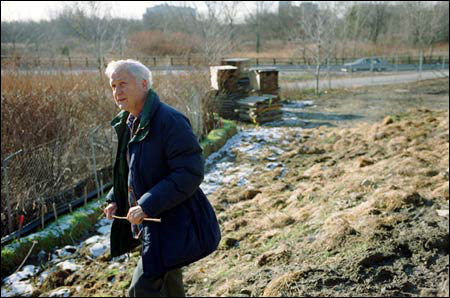Highway 61 – and 93 and 128 – revisited:
New book looks at what can be done to soften environmental impact of America’s four million miles of road

There are almost 4 million miles of road in the United States. Added together, these roads and roadsides make up more than 1 percent of the country, an area equal to South Carolina. But the area affected by the noise, pollution, animal deaths, and other ecological impacts linked to roads is much larger, 22 percent by one estimate.
Roads also cut the territory they run through into smaller parcels, often isolating animal populations and decreasing genetic diversity. The movement of water through a landscape is often altered or interrupted by roads, and this process may negatively impact fish and other aquatic life.
Even though they have such a massive effect on the natural world, roads have been pretty much ignored by ecologists, who prefer to focus on open areas – the territory between the roads. Nor have engineers and other specialists who design, build, and maintain roads been much concerned with the ecological effects of their creation.
Richard Forman, a landscape ecologist on the faculty of the Graduate School of Design, wondered why there was such a disconnect between these two groups and what could be done to get them talking. He decided that what was needed was a book that would bring together all that was known about roads and their impact on the landscape, but he knew that if such a book was to become the catalyst he hoped it would be, he could not be its sole author.
“I knew that if I wrote the book, it would be dismissed as the effort of an ecologist from a Northeastern university,” Forman said. “I wanted to make it a book that the transportation community couldn’t ignore.”
So Forman got together a dream team of authors who represented all sides of the road ecology problem. They included four road transportation experts, nine ecologists, and one hydrologist. About half the authors were academics and half government officials. Despite their disparate fields and points of view, the level of cooperation they achieved was surprising.
“Some of them thought the road system was bad but necessary. Others thought that it was good with certain drawbacks. But we had no real conflicts, because we all had the goal of getting the science out there.”
The book is not an edited volume, Forman pointed out. All 14 authors had a hand in writing every chapter. As the project went on, a real synergy developed among the group.
“All of us felt this was a really important thing to do. And we got a real bang out of working interdisciplinarily.”
The result of the collaboration is “Road Ecology: Science and Solutions” (Island Press, 2003). At 480 pages, it is a generous compendium of information about the nation’s road system, a combination of science, history, and practical solutions (or mitigations, as the authors call them). Many of these mitigations have already been used successfully in other countries, particularly in Europe, and so they cannot be dismissed as untried, impractical schemes designed by naïve dreamers.
“We don’t need to reinvent the wheel. Many of these things already exist,” Forman said.
For example, one way Europe (and to a much smaller extent, the United States and Canada) is solving the problem of animal habitats being sliced up by highways is by building overpasses that allow animals to travel safely over roads. Many of these overpasses, which are topped by earth, plants, and trees, have been built in France, Germany, Spain, and the Netherlands, and have substantially reduced animal road deaths.
Avoiding collisions between cars and migrating animals does not just benefit wildlife. Estimates of the number of deer killed annually on U.S. roads vary between 720,000 and 1.5 million. With an average vehicle repair bill of more than $1,500 for each collision, the cost is considerable.
Certain types of animals can learn to go under roads through specially designed culverts and underpasses. The United States has been quicker to adopt these types of mitigations, with Florida leading the way in an effort to save the rare Florida panther.
Not every mitigation requires an outlay of tax dollars. One of the book’s findings is that busy roads create an “avoidance zone” which is shunned by many types of wildlife.
“This suggests that it’s not a good use of funds for conservation organizations to be protecting wildlife habitats next to busy roads,” said Forman.
It is possible, on the other hand, to mitigate some of the highway noise by depressing the road, building soil berms, or planting more vegetation.
Federal lawmakers got a chance to hear the book’s findings on Dec. 3 when Forman and the other authors addressed a group of members of Congress and their staffers. Forman describes it as “a remarkable day,” marked by a degree of interest that exceeded everyone’s expectations. He believes it is the book’s impeccable scientific credentials and the interdisciplinary profile of its authors that impressed the lawmakers and hopefully will continue to drive change.
“The goal of transportation is safe and efficient human mobility. I believe that can be meshed with biodiversity and natural processes. We can do that in America, and this book is a step in getting us there.”




